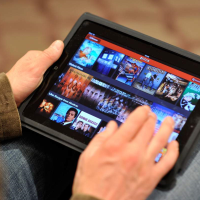Voters Increasingly Leaving TV for Internet as Source of Information
 (photo: Getty Images)
(photo: Getty Images)
By Maggie Haberman, New York Times
Voters have stepped away from the television and are digesting the presidential and Senate races through the internet, a new poll of persuadable voters in five Senate battleground states shows.
The survey (pdf), conducted by the Global Strategy Group, a Democratic firm, and Public Opinion Strategies, a Republican firm, showed that the information most influential to voters has migrated to social media, fact checkers and media websites, as people scale back their television-viewing habits.
“These persuadable voters, where they’re going to get their information is less TV, but really online,” said Robert Blizzard, the Republican pollster who conducted the survey with a Democratic counterpart, Julie Hootkin.
Television still plays a role in allowing candidates to introduce themselves to voters and “setting the tone for the race,” Blizzard said. But he said that an engaged online presence was increasingly the hallmark of persuadable voters.
The study, commissioned by Google, surveyed 500 persuadable voters in New Hampshire, Florida, Nevada, North Carolina and Pennsylvania from Oct. 13-18.
It found that 52 percent of those voters get their information from television, down 8 percentage points since 2012. Some 73 percent of the voters own a smartphone, and 40 percent said they spend no time watching television at all during any particular week.
“In terms of TV, the percentage of Americans who are cutting the cord is obviously growing by the day,” Blizzard said.
“The notion that campaigns are trying to reach these late deciders, and they’re not getting their information from television, is significant,” Hootkin said.
Half of those voters surveyed have used the internet to fact-check things they have learned in the news media during the course of the campaign. Half have done the same to fact-check things that the candidates have said this cycle.
Most telling was that 76 percent of the voters said they watched at least one of the presidential debates when they aired. But a third of those who watched were simultaneously engaged online, whether it was to check what was being said about the debate on Twitter or to see what fact checkers were saying about specific points.
The takeaway for future campaigns is that candidates and their aides will need to increasingly tailor approaches to the internet for what were once staples of television.
“Television is not going to cut it alone,” Blizzard said.
To Learn More:
Persuadable Voters in Key Senate Battleground States (Global Strategy Group) (pdf)
As Political Advertising Follows Public from TV to Internet, Transparency Suffers (by Noel Brinkerhoff, AllGov)
TV Was Biggest Winner in Mid-Term Election, Reaping $2.4 Billion in Political Ad Sales (by Noel Brinkerhoff, AllGov)
Political Campaigns find that Online Advertising Space—Just Like TV and Print—has Its Limits (by Noel Brinkerhoff, AllGov)
- Top Stories
- Unusual News
- Where is the Money Going?
- Controversies
- U.S. and the World
- Appointments and Resignations
- Latest News
- Trump to Stop Deportations If…
- Trump Denounces World Series
- What If China Invaded the United States?
- Donald Trump Has a Mental Health Problem and It Has a Name
- Trump Goes on Renaming Frenzy






Comments